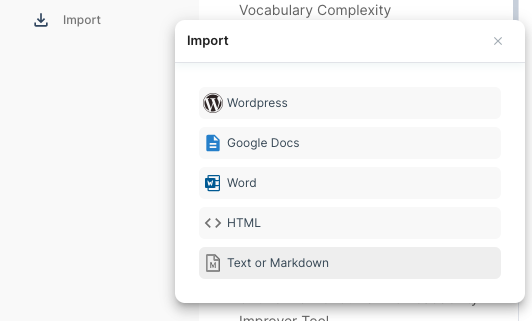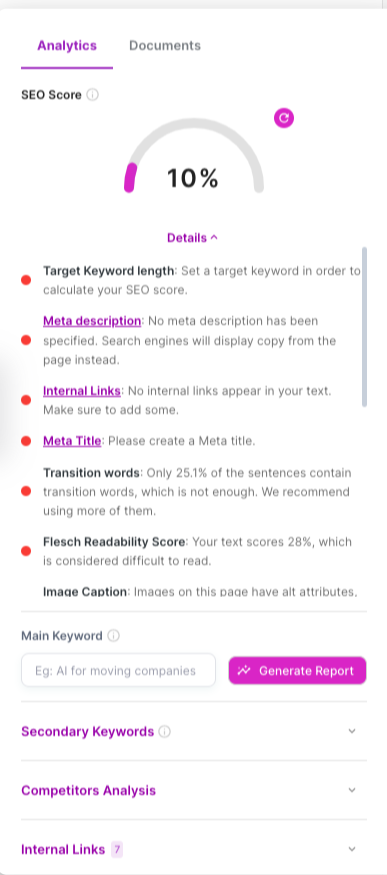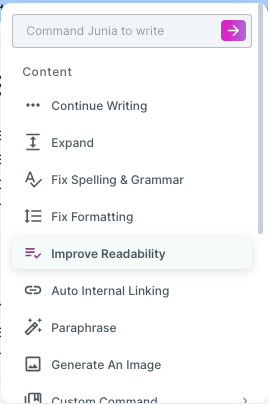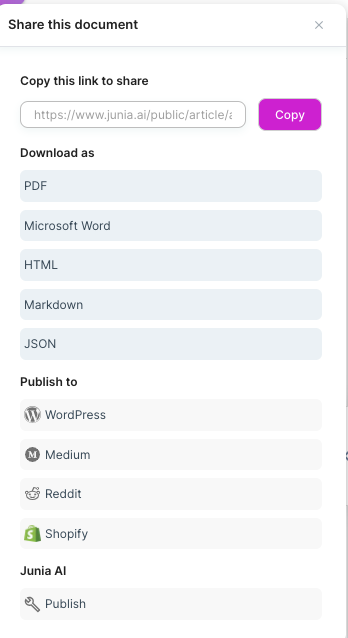Free Readability Improver Tool

Readability is extremely important for the quality of your content and how it affects your SEO ranking. Making sure that your content is easy to read and understand not only improves the experience for your readers but also helps search engines find and rank your pages.
Luckily, there are many tools available that can help you improve the readability of your content. One such tool is Junia AI's Readability Improver Tool. This tool has advanced features that can make your content more engaging and accessible to your target audience. By using this tool, you can optimize your content for a better reading experience and increase its chances of ranking higher in search results.
With so many AI content generator tools out there that offer readability improvement like Junia AI, Jasper AI, LongShot AI, Surfer SEO and Hemingway Editor, and others, it can be hard to choose the right one for you. But Junia AI's Readability Improver Tool is a standout option because it uses artificial intelligence to analyze and improve the readability of your content.
In the rest of this article, we'll look at what readability scores are and why they matter, take a detailed look at Junia AI's Readability Improver Tool, examine the pros and cons of automated readability tools, explore manual ways to improve readability, help you decide which tool is best for you, and discuss where readability technology is headed in the future.
So let's get started on this journey to improving your content's readability with Junia AI's Readability Improver Tool!
Understanding Readability Scores and Their Significance
What is a Readability Score?
A readability score is a way to measure how easy or difficult it is to read a piece of writing. It tells us how well the text can be understood by its intended audience. This measurement takes into account different factors, such as the words used and how they are put together in sentences and paragraphs.
How is a Readability Score Calculated?
To calculate a readability score, special algorithms analyze things like sentence length, word complexity, and syllable count. These calculations help determine the overall difficulty level of the text. One commonly used readability score is called the Flesch Reading Ease score.
Why are Readability Scores Important?
Readability scores have two main purposes:
- Evaluating content quality: By looking at the readability score, we can get an idea of how well-written a piece of content is. This helps us assess whether it matches the reading abilities and preferences of the target audience.
- Improving reader-friendliness: Readability scores also help us understand how easy or difficult it is for readers to engage with the writing. Authors can use this information to make changes that will make their content clearer and more enjoyable for their audience.
By paying attention to readability scores and what they mean, writers can make better choices about how to create content that is both accessible and impactful. The Flesch Reading Ease score, among others, is a useful tool for this purpose.
Common Elements Evaluated in Readability Scores
When it comes to assessing the readability of content, several key elements play a crucial role in determining the overall quality and reader-friendliness. These elements are carefully evaluated to ensure that the content is easily comprehensible and engaging for the target audience.
Sentence Structure
The structure of sentences within a piece of content greatly influences its readability. Complex and convoluted sentences can pose challenges for readers, leading to confusion and disengagement. On the other hand, clear and well-structured sentences enhance comprehension and create a smoother reading experience. Evaluating sentence structure involves analyzing factors such as sentence length, use of subordination, and overall coherence.
- Sentence Length: Longer sentences with multiple clauses or excessive verbosity can hinder readability. Shorter, concise sentences are generally preferred to maintain reader engagement.
- Subordination Usage: Excessive use of complex subordination, such as nested clauses or intricate phrasing, can make sentences challenging to follow. Simplifying subordination can enhance clarity.
- Coherence: The logical flow and coherence of sentences contribute significantly to the overall readability of content. Well-organized ideas presented in a coherent manner help readers grasp the intended message more effectively.
Vocabulary Complexity
The complexity of vocabulary used in content directly impacts its accessibility and comprehensibility for the audience. Overly technical or esoteric language may alienate readers, while excessively simple language might undermine the depth and sophistication of the message being conveyed.
- Word Choice: Selecting appropriate words that align with the target audience's familiarity with language is essential for optimizing readability. Avoiding jargon or overly complex terminology can enhance accessibility.
- Clarity vs. Sophistication: Balancing clarity and sophistication in vocabulary usage is crucial. Striking a harmonious blend that communicates ideas effectively without overwhelming readers is key to achieving optimal readability.
Understanding these fundamental elements and their impact on readability scores is vital for creating high-quality, reader-friendly content that resonates with audiences across diverse demographics and preferences. By addressing sentence structure and vocabulary complexity with precision, content creators can elevate the overall quality of their writing and enhance reader engagement significantly.
Junia AI's Readability Improver Tool: An In-Depth Review
Junia AI's Readability Improver Tool offers a range of advanced features designed to enhance the overall readability of your content. Let's delve into the key elements that make this tool a valuable asset for content creators and marketers.
Key Features of Junia AI's Readability Improver Tool
%20(1).png?token=eyJhbGciOiJIUzI1NiIsInR5cCI6IkpXVCJ9.eyJ1cmwiOiJ1c2VyLWdlbmVyYXRlZC1pbWFnZXMvYmM1OGY0NzktYTkwNS00MWY4LWIxZmEtZDU2ZGMxM2E4ZThkL0dyb3VwIDM3OSAoMSkgKDEpLnBuZyIsImlhdCI6MTcwMTg2OTM3OSwiZXhwIjoyMDE3MjI5Mzc5fQ.vXdESNbulZO-8ujj4eCKbvlMX2eBSK8_tJ2xKcD38Mo)
1. Inline Suggestions for Clarity and Structure
Junia AI's inline suggestions feature is a game-changer when it comes to refining the clarity and structure of your sentences. This feature provides real-time recommendations, allowing you to seamlessly optimize your content as you write. By receiving instant feedback on sentence construction and clarity, you can refine your content in a dynamic and efficient manner.
2. One-Click Optimization for Streamlined Readability Enhancements
The tool's one-click optimization function is another standout feature that significantly streamlines the process of enhancing overall readability. With just a simple click, users can implement comprehensive optimizations across their content, ensuring that it meets the highest standards of readability. This user-friendly functionality empowers writers to elevate the quality of their content with unparalleled ease and efficiency.
3. Powerful Solution for Various Content Types
By combining these features, Junia AI's Readability Improver Tool equips users with a powerful solution for effortlessly enhancing the readability of their content. Whether you're crafting blog posts, marketing copy, or website content, this tool offers an intuitive and effective approach to optimizing readability.
How Junia AI Utilizes AI Technology to Enhance Readability
Junia AI's Readability Improver Tool uses artificial intelligence to analyze and improve content readability. It provides insights and suggestions to help writers make their writing clearer and more organized.
How Junia AI's Custom AI Models Work
- Junia AI's custom AI models use advanced algorithms and machine learning to assess different aspects of readability, such as sentence structure, vocabulary complexity, and overall flow.
- These models have been trained on a large amount of text data, enabling them to accurately evaluate the readability of different types of content.
- One of the key features of Junia AI's AI models is their ability to give suggestions in real-time. As users write or edit their content, the tool offers recommendations for improving sentence clarity and structure.
- This helps writers identify areas where their sentences may be too complicated or confusing, so they can make the necessary changes for better readability.
The Benefits of Junia AI's AI Technology for Readability Enhancement
- Inline Suggestions: By providing suggestions as users type, Junia AI's tool makes it easier for writers to see where improvements can be made immediately.
- One-Click Optimization: With just one click, users can instantly improve the overall readability of their content. The tool applies a set of optimizations based on the analysis of the AI models.
- Time-Saving: Instead of manually identifying and fixing readability issues, writers can rely on Junia AI's tool to do it quickly and efficiently.
- Improved Engagement: Content that is easy to read and understand is more likely to capture readers' attention and keep them engaged.
Limitations of Junia AI's Readability Improver Tool
While Junia AI's AI models are effective in enhancing sentence-level clarity and structure, there are a few things to keep in mind:
- The tool may not address larger structural issues in a piece of writing.
- The suggestions provided by the tool may not always match a writer's preferred style or tone.
- It's important for writers to use their own judgment and make adjustments accordingly.
Despite these limitations, Junia AI's Readability Improver Tool is a valuable resource for content creators looking to improve the readability of their work. By combining the power of AI with human creativity and judgment, writers can create content that is both informative and easy to understand for their target audience.
Step-by-Step Guide on Using Junia AI's Readability Improver Tool
Junia AI's Readability Improver Tool offers a user-friendly interface and powerful features that can significantly enhance the readability of your content. Here's a detailed guide on how to effectively utilize this tool for optimizing content readability, along with practical examples:
1. Accessing the Tool
After logging into your Junia AI account, navigate to the dashboard and create a new document where you'll access the AI text editor provided by Junia AI and where the Readability Improver Tool is included.
2. Uploading Your Content

Input your text, plain text, HTML, or markdown supported into the editor. This can be an article, blog post, product description, or any other piece of written content that you want to improve for better readability.
3. Overview of Junia AI's Readability Improver Tool
Upon uploading your content, you'll be presented with an overview of the tool's capabilities, highlighting its features and benefits for content creators. This includes inline readability suggestions and one-click optimization.
4. Inline Readability Suggestions

As the tool processes your content, it provides real-time inline suggestions to improve sentence clarity and structure. These suggestions are based on advanced AI algorithms that analyze your writing style and provide tailored recommendations. The tool identifies areas where sentences may be too complex or poorly structured and offers suggestions to make them more concise and easy to understand.
5. One-Click Optimization

Utilize the one-click optimization function to quickly enhance the overall readability of your content. This feature streamlines the process by implementing multiple improvements simultaneously, saving you valuable time while ensuring high-quality results. With just a single click, you can implement all the suggested changes throughout your entire document.
6. Practical Examples
Let's consider a practical example: Suppose you've written a product description with complex sentences and technical jargon. Junia AI's Readability Improver Tool would identify these areas and offer specific suggestions to simplify language and improve comprehension. For instance, it may suggest replacing technical terms with simpler alternatives or breaking down long sentences into shorter ones for easier reading.
7. Monitoring Progress
Throughout the optimization process, you can monitor the changes being made to your content in real time. This transparency allows you to see exactly how the tool is enhancing your content's readability. You'll be able to visually track the improvements made by observing the modifications directly within the AI text editor.
8. Saving and Exporting

Once you're satisfied with the improvements, simply save the optimized version of your content directly from the tool. You can then seamlessly integrate it into your publishing workflow or share it with collaborators. The tool allows you to export your optimized content in various formats such as plain text, HTML, or markdown, depending on your specific needs.
By following these steps and taking advantage of Junia AI's innovative features, you can elevate the readability of your content while streamlining your editing process. The Readability Improver Tool empowers you to create clear, concise, and engaging content that resonates with your audience and drives better results.
The Pros and Cons of Automated Readability Tools
Automated readability tools like AISEO and LongShot AI offer several advantages for content creators, making them popular choices in the digital landscape. Here are the key pros and cons of using these tools:
Advantages of Automated Readability Tools
- Time Efficiency: These tools enable quick assessment and enhancement of content readability, saving significant time for content creators and marketers.
- Comprehensive Analysis: Automated readability tools provide in-depth analysis of content, highlighting hard-to-read sentences, suggesting replacements, simplifying complex phrases, and offering real-time recommendations for sentence and paragraph enhancement.
- SEO Optimization: By improving content readability, these tools contribute to enhanced SEO ranking and increased organic traffic. This is crucial for driving visibility and engagement on digital platforms.
Disadvantages of Automated Readability Tools
- Limitations in Creativity: While these tools excel in enhancing structure and clarity, they may restrict the creative expression of writers by imposing rigid readability standards.
- Overreliance on Technology: There's a risk of overdependence on automated tools, potentially hindering the development of manual editing skills and a deeper understanding of effective writing techniques.
- Cost Considerations: Some advanced features or comprehensive usage may require premium subscriptions or additional costs, impacting the budget for content creation and optimization efforts.
In summary, the use of automated readability tools presents notable benefits in terms of efficiency, analysis, and SEO optimization. However, it's essential to balance their advantages with potential limitations related to creativity, reliance on technology, and cost considerations. Understanding these factors can help content creators make informed decisions when incorporating automated readability tools into their workflow.
Manual Optimization Techniques for Improving Readability
When it comes to improving readability, software tools like AISEO and LongShot AI can be incredibly helpful. However, there are also alternative approaches that you can take to enhance content readability without relying solely on these tools. By implementing manual optimization techniques, you can further refine your writing and make it more reader-friendly. Here are some strategies to consider:
1. Simplify Sentence Structure
- Use shorter sentences: Long and complex sentences can be difficult for readers to follow. Aim to keep your sentences concise and straightforward.
- Break up long paragraphs: Large blocks of text can be intimidating and overwhelming for readers. By breaking them up into smaller paragraphs, you create more white space and make the content easier to digest.
2. Clarify Language and Vocabulary
- Avoid jargon: Unless you're writing for a specialized audience, try to use language that is accessible to a broader range of readers. Minimize the use of technical terms and explain any complex concepts in simpler terms.
- Define unfamiliar words: If you do need to include technical terms or industry-specific terminology, provide clear definitions or context to help readers understand their meaning.
3. Use Headings and Subheadings
- Organize your content: Headings and subheadings act as signposts for readers, guiding them through your content and making it easier to navigate. Breaking up your text with clear headings helps readers quickly find the information they're looking for.
4. Incorporate Bullet Points or Numbered Lists
- Highlight key points: Bullet points or numbered lists help break down information into bite-sized chunks, making it easier for readers to scan and comprehend. They draw attention to important details and improve the overall readability of your content.
5. Include Visuals
- Utilize images or infographics: Visual elements can enhance understanding and engagement with your content. They provide a visual break from text and can help illustrate complex ideas or data.
6. Proofread and Edit
- Take the time to review your content: While software tools can catch many errors, they may not always pick up on contextual issues or awkward phrasing. Proofread your content carefully, checking for any areas that could be improved for clarity and flow.
By implementing these manual optimization techniques, you can enhance the readability of your content even further. While software tools are valuable resources, combining them with these strategies will ensure that your writing is clear, engaging, and accessible to a wider audience.
Choosing the Right Readability Improver Tool for Your Needs
When it comes to selecting a readability tool, there are several factors you should consider to ensure you choose the right one for your needs. Here are some key points to keep in mind:
1. Pricing Plans
Evaluate the pricing plans of different readability improver tools to find one that fits within your budget. Consider whether they offer a free trial or a money-back guarantee to test the tool's effectiveness before committing.
2. Customer Support Quality
Look for tools that provide excellent customer support, such as live chat, email support, or comprehensive documentation. This will be beneficial if you encounter any issues or have questions while using the tool.
3. User-Friendliness
Consider how user-friendly the tool is and whether it aligns with your workflow. Look for features like a clean interface, easy navigation, and intuitive functionalities that make it convenient to use.
4. Customization Options
Determine if the readability tool allows customization based on your specific requirements. For instance, some tools may offer options to adjust the target audience age group or customize the level of simplicity in the content.
5. Integration with Existing Tools
If you already use other writing or content management tools, check if the readability improver tool integrates seamlessly with them. Integration can streamline your workflow and save time by eliminating the need for manual transfers.
6. Additional Features
Explore any additional features offered by the tool that may enhance your content creation process. For example, some tools may provide grammar and spelling checks, plagiarism detection, or suggestions for improving SEO optimization.
7. Reviews and Recommendations
Read reviews and seek recommendations from trusted sources or colleagues who have used readability improver tools before. Their insights can give you a better understanding of each tool's strengths and weaknesses.
By considering these factors, you can narrow down your options and choose a readability improver tool that best suits your needs, budget, and workflow. Remember to weigh the pros and cons of each tool and prioritize the features that are most important to you.
Integrating Readability Enhancers into Your Content Creation Workflow
Incorporating readability tools in content creation involves seamlessly integrating these tools into your writing process. Here are some practical tips to help you effectively integrate AISEO and LongShot AI into your content creation workflow:
1. Initial Familiarization:
Take the time to familiarize yourself with the features and functionalities of the readability enhancer tools. Explore their capabilities and understand how they can assist you in optimizing your content's readability.
2. Customized Writing Process:
Tailor your writing process to accommodate the use of these tools. Consider incorporating them at specific stages, such as during the editing phase, to ensure a smooth and efficient workflow.
3. Regular Training and Updates:
Stay updated with any new features or updates released for the tools. Regularly train yourself on utilizing these enhancements effectively to maximize their impact on your content.
4. Consistent Application:
Integrate the use of these tools consistently across various types of content creation, whether it's blog posts, articles, or website copy. Consistent application will help you maintain a high level of readability across all your content.
5. Feedback Loop Integration:
Incorporate a feedback loop where you analyze the suggestions and improvements provided by the tools. Use this feedback to enhance your writing skills and gain insights into areas that require improvement.
6. Collaborative Workflows:
If you work in a team, ensure that everyone is aligned with the use of readability enhancer tools. Establish guidelines for their integration into collaborative writing processes for seamless teamwork.
7. Monitoring Effectiveness:
Regularly monitor the effectiveness of these tools in improving the overall readability of your content. Keep track of metrics such as reader engagement, bounce rates, and SEO performance to assess their impact.
By seamlessly integrating AISEO and LongShot AI into your content creation workflow, you can elevate the quality and reader-friendliness of your written material while also optimizing it for search engines. These tools serve as valuable assets in enhancing the overall impact and effectiveness of your content across various digital platforms, ensuring that it resonates with your target audience while meeting SEO requirements.
The Future of Readability Technology: Trends and Predictions
As we look ahead to the future of readability tools, it's evident that AI-driven advancements will continue to revolutionize content creation and optimization. Here are some potential trends and predictions for the future of readability technology:
Enhanced Natural Language Processing (NLP)
With ongoing developments in natural language processing, readability tools are likely to become even more adept at understanding context, tone, and style in written content. This will enable these tools to offer more nuanced and tailored suggestions for improving readability, making them indispensable assets for writers across diverse industries.
Contextual Recommendations
Future readability tools may incorporate advanced contextual analysis to provide more specific and targeted recommendations. By considering the overall theme and purpose of the content, these tools will offer personalized suggestions to enhance clarity and coherence, ultimately elevating the overall quality of the writing.
Integration with Content Creation Platforms
As the demand for seamless workflow integration grows, readability tools are expected to integrate more extensively with popular content creation platforms. This integration will enable users to access readability enhancement features directly within their preferred writing environments, streamlining the optimization process.
Multilingual Readability Enhancement
With globalization shaping digital content creation, the future of readability technology is likely to include robust multilingual capabilities. Advanced AI models will be designed to assess and enhance readability across various languages, catering to a diverse global audience and expanding the reach of these tools.
Real-time Collaboration Features
In an increasingly interconnected digital landscape, future readability tools may introduce real-time collaboration features that facilitate concurrent editing and optimization by multiple users. This collaborative functionality will empower teams to enhance readability collectively, fostering efficient teamwork and knowledge sharing.
Ethical Considerations in Readability Enhancement
As AI-driven readability enhancement becomes more pervasive, ethical considerations surrounding data privacy, bias mitigation, and algorithm transparency will come to the forefront. The future of readability technology will likely involve an increased focus on ethical practices and responsible deployment of AI in content optimization.
The evolution of readability technology holds great promise for empowering writers, marketers, and businesses to create compelling, reader-friendly content with greater ease and efficiency. As these anticipated advancements unfold, the landscape of digital content creation is poised to undergo significant transformation, driving higher standards of quality and accessibility in written communication.
Conclusion
Readability improver tools have become an essential resource for content creators looking to enhance the quality and impact of their writing. By leveraging the power of tools like AISEO, LongShot AI, and Junia AI's Readability Improver Tool, you can take your content to the next level and engage your readers more effectively.
Here are some final thoughts on readability tools:
- Elevate your content quality: By using these tools, you can optimize your writing for improved clarity, structure, and overall readability. This not only enhances the user experience but also boosts your SEO ranking and drives organic traffic to your website.
- Save time and effort: Automated readability tools offer comprehensive analysis and suggestions for improvement, saving you valuable time that can be better utilized in other aspects of content creation.
- Combine automation with manual optimization: While automated tools provide a great starting point, it's important to remember that they are not foolproof. Manual optimization techniques can complement these tools by addressing specific nuances and ensuring a personalized touch to your content.
- Consider your specific needs: When choosing a readability improver tool, evaluate factors such as pricing plans, customer support quality, and the specific features that align with your content creation workflow.
In the future, we can expect continued advancements in AI-driven readability enhancement. These tools will likely become even more sophisticated in analyzing and improving various aspects of content readability. The possibilities for seamless integration into the content creation process are vast.
So why wait? Start leveraging the power of readability improver tools today and elevate the quality of your content. Whether it's AISEO, LongShot AI, or Junia AI's Readability Improver Tool, these resources will help you create engaging, reader-friendly content that stands out in today's digital landscape.
